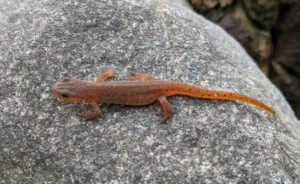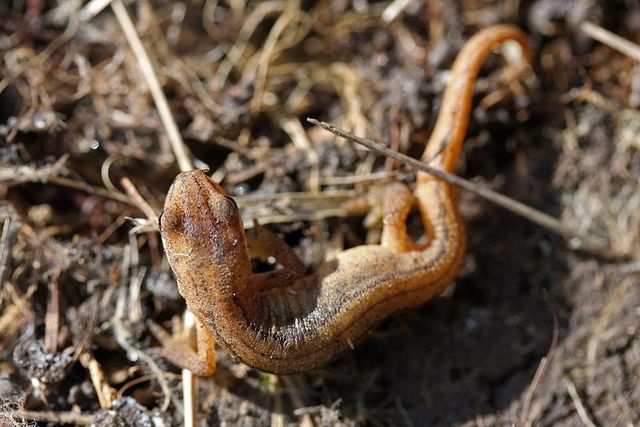Salamanders start life as small, soft-bodied animals that hatch in water or damp soil. As they grow, they go through different stages, from larva to juvenile to adult.
The juvenile stage is important. It comes right after metamorphosis, when the salamander leaves its baby form behind but is not yet fully grown.
Juvenile salamanders eat small live animals like insects, worms, spiders, and tiny crustaceans. They are meat-eaters and need to hunt food that moves. Their diet changes as they grow bigger and stronger.
What Is a Juvenile Salamander?
A juvenile salamander is a young salamander that has passed the larval stage but is not yet an adult.
For species that start in water, the juvenile appears after metamorphosis. This is when the salamander loses its gills, develops legs, and gains the ability to live on land or stay in water.

Juveniles are more independent than larvae. They can find food, move to new places, and hide from predators. Their bodies work like adults, just on a smaller scale.
Do Juveniles Eat the Same Food as Adults?
Yes and no. Juveniles eat similar kinds of food, but they focus on smaller prey.
Because they are smaller and have weaker jaws, they need food that is soft, slow, or small enough to swallow whole. A
s they grow, they can handle larger insects or prey that would be too much for a newly transformed salamander.
What Do Land-Dwelling Juveniles Eat?
Land-based juveniles hunt for soft-bodied prey near the forest floor, in leaf litter, under logs, or in mossy soil.
Common foods include:

- Small insects like ants, beetles, and fly larvae
- Worms, such as earthworms and small roundworms
- Spiders and tiny arthropods
- Snails and small slugs
- Mites, springtails, and other micro-creatures
They use their tongues or jaws to catch moving prey. Their sense of smell and touch helps them find food in dark, damp areas. They avoid dry or open spots because their skin needs moisture.
What Do Aquatic Juveniles Eat?
Some juvenile salamanders stay in water. This is common for stream-living species or those that remain in water longer.

These young salamanders hunt underwater. Their diet may include:
- Aquatic insect larvae, like mosquito or dragonfly larvae
- Tiny crustaceans, such as water fleas and copepods
- Worms and other soft-bodied animals
- Tadpoles (if small enough)
- Small snails or aquatic bugs
Aquatic juveniles often use quick lunges or suction feeding to pull prey into their mouths. Clear, shallow water with lots of insects and hiding spots is best.
Do All Juveniles Hunt the Same Way?
No. How a juvenile hunts depends on species, body shape, and environment.
Some use their tongue to catch prey. Others grab with their jaws. Aquatic species may open their mouths quickly to suck prey in with water.
Stream dwellers may brace themselves with their tails while hunting.
Others move slowly and rely on surprise. Even young salamanders show special behaviors based on where they live.
Can Juvenile Salamanders Eat Plants?
No. Juvenile salamanders only eat meat. Even near moss or algae, they will not feed on plants. Their digestive systems are built for animal protein.
If you keep one as a pet, it must be fed live or frozen animals, not vegetables or fruit.
How Often Do Juveniles Eat?
Juveniles have fast metabolisms and need to eat often to grow.
In the wild, they may hunt several times a day, depending on temperature, season, and food availability. In cool weather, they eat less. In warm, wet conditions, they feed more.
Pet juveniles usually need food every day or every other day, with small portions. They stop eating when full, so frequent small meals work better than large ones.
What Do Captive Juveniles Eat?
Food for captive juveniles should mimic what they find in nature. Examples include:
- Pinhead crickets
- Flightless fruit flies
- White worms
- Small earthworms
- Microworms or springtails
- Bloodworms (for aquatic juveniles)
- Tiny blackworms or chopped nightcrawlers
All food should be clean and free of chemicals. For land species, put food in shallow dishes or on damp soil. For aquatic juveniles, add food to the water and remove leftovers quickly.
Do Juvenile Salamanders Eat Each Other?
Yes, some will eat other juveniles if food is limited. This usually happens when:
- There is not enough food
- The young are crowded
- Some are bigger than others
- They are kept in small containers without hiding spots
In the wild, juveniles often spread out after metamorphosis to avoid competing. In captivity, separate them or provide many hiding spots to prevent aggression.
Do Juveniles Change Their Diet as They Grow?
Yes. As juveniles grow, their diet expands. They may start with tiny worms or insects and move to larger bugs, beetle larvae, or small amphibians.
Their jaws get stronger, and their stomachs can handle tougher prey. Adult salamanders may eat:
- Full-sized crickets
- Large worms
- Snails with shells
- Small fish or amphibians (depending on species)
The basic needs remain the same: moisture, protein, and live or moving food.
What Happens If Juveniles Don’t Get the Right Food?
Without proper food, juveniles may:
- Stop growing
- Become weak or sick
- Fail to develop strong limbs
- Lose color or energy
- Die before adulthood
They need protein, moisture, and nutrients like calcium to grow properly. In captivity, this is often given by dusting insects with special powder. Feeding the wrong food or not enough can shorten their lives.
Are Juvenile Salamanders Important in the Wild?
Yes. Juveniles are key players in the food web. They help control insects, recycle nutrients, and feed larger predators.
They are eaten by:
- Birds
- Fish
- Frogs
- Snakes
- Small mammals
Even though many do not reach adulthood, they help keep ecosystems in balance.
Conclusion
Juvenile salamanders eat a variety of small, live animals, including insects, worms, spiders, and tiny aquatic creatures. They do not eat plants.
Their diet depends on size, species, and whether they live in water or on land.
Hi, my name is Ezra Mushala, i have been interested animals all my life. I am the main author and editor here at snakeinformer.com.

